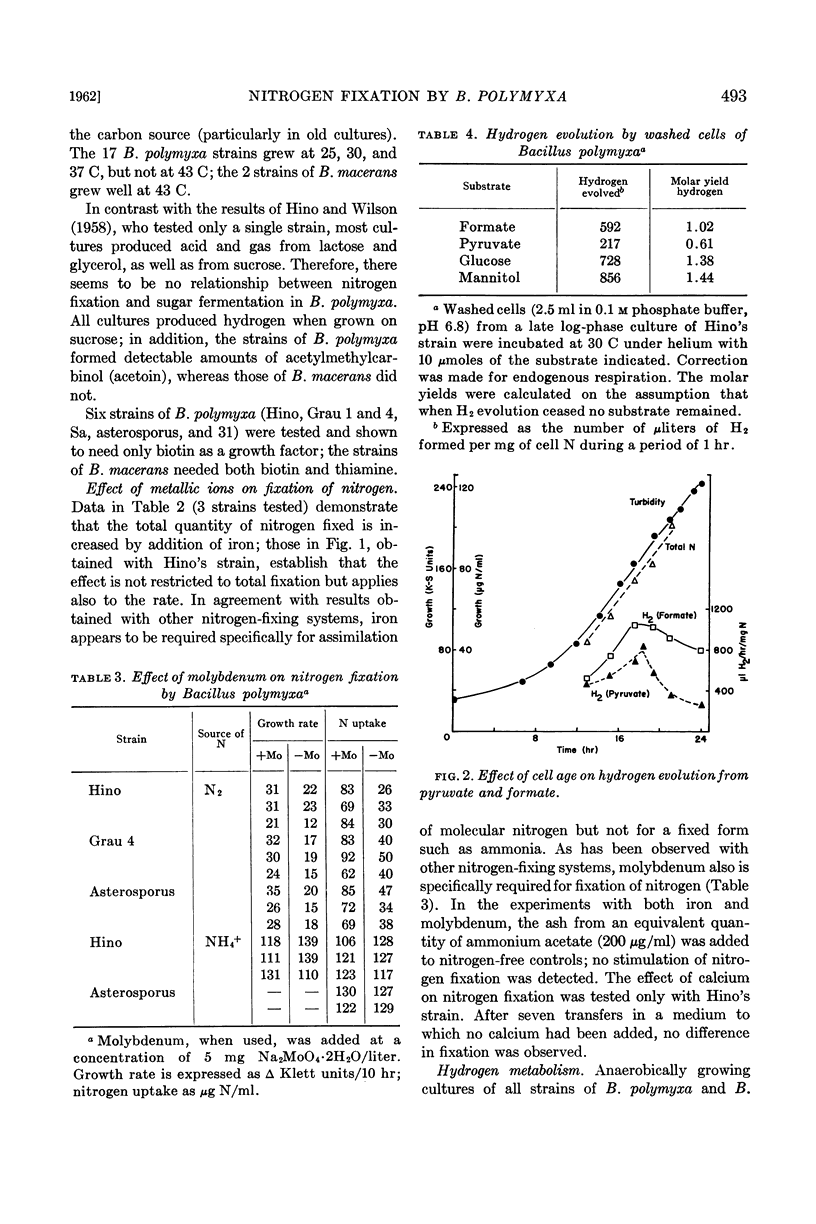Abstract
Grau, F. H. (University of Wisconsin, Madison) and P. W. Wilson. Physiology of nitrogen fixation by Bacillus polymyxa. J. Bacteriol. 83:490–496. 1962.—Of 17 strains of Bacillus polymyxa tested for fixation of molecular nitrogen, 15 fixed considerable quantities (30 to 150 μg N/ml). Two strains of the closely related B. macerans did not use N2, but possibly other members of this species may do so. Confirmation of fixation was obtained by showing incorporation of N15 into cell material.
Both iron and molybdenum are specifically required for fixation; without the addition of these metals to the nitrogen-free medium, the growth rate and the total nitrogen fixed were reduced about 30 to 50%. No requirement for added molybdenum could be shown when ammonia was the nitrogen source, and the absence of iron caused only a slight decrease in growth. Washed-cell suspensions of B. polymyxa containing an active hydrogenase readily incorporated N15 into cell materials when provided with mannitol, glucose, or pyruvate but not when formate was the substrate. Hydrogen is a specific inhibitor of fixation, reducing both the rate and final amount of nitrogen fixed; it did not reduce growth on ammonia. Fixation was strictly anaerobic, 1% oxygen in the gas phase being sufficient to stop fixation. Arsenate is a powerful inhibitor of fixation of N2 by washed-cell suspensions of B. polymyxa, indicating that high-energy phosphate may be significant for this process.
Full text
PDF






Selected References
These references are in PubMed. This may not be the complete list of references from this article.
- HAMILTON R. D., WOLFE R. S. Pyruvate exchange reactions in Bacillus macerans. J Bacteriol. 1959 Aug;78:253–258. doi: 10.1128/jb.78.2.253-258.1959. [DOI] [PMC free article] [PubMed] [Google Scholar]
- HINO S., WILSON P. W. Nitrogen fixation by a facultative bacillus. J Bacteriol. 1958 Apr;75(4):403–408. doi: 10.1128/jb.75.4.403-408.1958. [DOI] [PMC free article] [PubMed] [Google Scholar]
- PECK H. D., Jr, GEST H. A new procedure for assay of bacterial hydrogenases. J Bacteriol. 1956 Jan;71(1):70–80. doi: 10.1128/jb.71.1.70-80.1956. [DOI] [PMC free article] [PubMed] [Google Scholar]
- PENGRA R. M., WILSON P. W. Physiology of nitrogen fixation by Aerobacter aerogenes. J Bacteriol. 1958 Jan;75(1):21–25. doi: 10.1128/jb.75.1.21-25.1958. [DOI] [PMC free article] [PubMed] [Google Scholar]
- TEMPERLI A., PENGRA R. M., WILSON P. W. Some properties of a soluble and particle-bound hydrogenase in Aerobacter aerogenes. Biochim Biophys Acta. 1960 Mar 11;38:557–558. doi: 10.1016/0006-3002(60)91294-4. [DOI] [PubMed] [Google Scholar]
- WESTLAKE D. W., WILSON P. W. Molecular hydrogen and nitrogen fixation by Clostridium pasteurianum. Can J Microbiol. 1959 Dec;5:617–620. doi: 10.1139/m59-075. [DOI] [PubMed] [Google Scholar]


